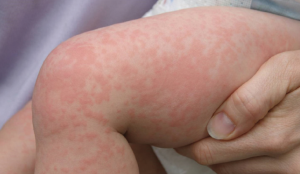Chapter 11: Drug Reactions
Morbilliform Drug Reaction
What is it?
Morbilliform drug eruptions, also known as maculopapular or exanthematous drug eruptions, are the most common form of drug eruption and do not cause any serious harm to the patient.
What causes it?
Antibiotics are the most common causes (especially aminopenicillins, cephalosporins and sulfonamides), but almost any medication can be responsible.
What does it look like?
The rash consists of widespread small blanchable erythematous macules and papules appearing 5-14 days after starting the medication. Pruritus is common.
How is it diagnosed?
Morbilliform drug rash is diagnosed clinically. Drug history should include any topical, over-the-counter, and natural health products the patient has been using. It might not be possible to definitively differentiate a morbilliform drug reaction from a viral exanthem or to know with certainty which medication was the culprit.
How is it treated?
Once the responsible medication is stopped, the rash typically resolves in 7-14 days. However, if a medication is considered necessary, you can “treat through” the rash as morbilliform drug eruptions are not life threatening. Topical corticosteroids and/or oral antihistamines are helpful for control of associated itch.


